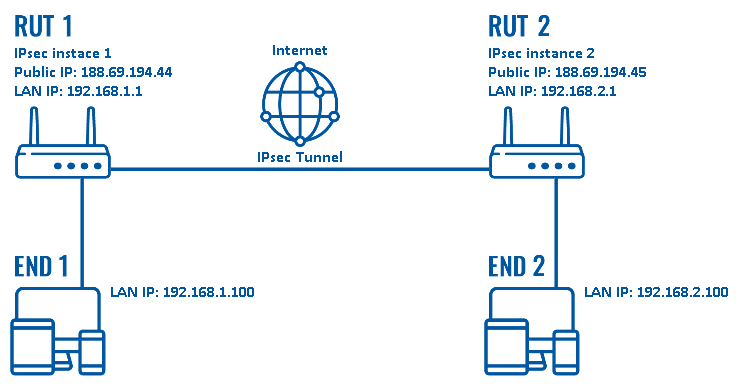IPsec configuration examples: Difference between revisions
No edit summary |
No edit summary |
||
| Line 12: | Line 12: | ||
* Two RUTxxx routers of any type (excluding RUT850) | * Two RUTxxx routers of any type (excluding RUT850) | ||
* Both routers must have a Public Static or Public Dynamic IP addresses | * Both routers must have a Public Static or Public Dynamic IP addresses | ||
* At least | * At least one end device (PC, Laptop, Tablet, Smartphone) to configure the routers | ||
* (Optional) A second end device to configure and test remote LAN access | |||
---- | ---- | ||
There will be two IPsec configuration schemes presented. Although the second scheme is only an extension of the first one. Therefore, to configure the second scheme, you will have to configure the first as well. | |||
[[File:Configuration examples | '''Configuration scheme 1''': | ||
[[File:Configuration examples ipsec scheme 1.png]] | |||
The figure above above depicts two RUTxxx routers (RUT1 and RUT2) connected by an IPsec tunnel via the Internet. | |||
---- | |||
'''Configuration scheme 2''': | |||
[[File:Configuration examples ipsec scheme.png]] | |||
For the sake of better understanding, lets look at sche | |||
Revision as of 06:59, 5 June 2018
Introduction
In computing, Internet Protocol Security (IPsec) is a secure network protocol suite of IPv4 that authenticates and encrypts the packets of data sent over an IPv4 network. IPsec includes protocols for establishing mutual authentication between agents at the beginning of the session and negotiation of cryptographic keys to use during the session. IPsec can protect data flows between a pair of hosts (host-to-host), between a pair of security gateways (network-to-network), or between a security gateway and a host (network-to-host). Internet Protocol security (IPsec) uses cryptographic security services to protect communications over Internet Protocol (IP) networks. IPsec supports network-level peer authentication, data-origin authentication, data integrity, data confidentiality (encryption), and replay protection.
This article provides an extensive configuration example with details on how to create a connection between two IPsec instances, both of which configured on RUTxxx routers.
Configuration overview and prerequisites
Before we begin, let's overview the configuration that we are attempting to achieve and the prerequisites that make it possible.
Prerequisites:
- Two RUTxxx routers of any type (excluding RUT850)
- Both routers must have a Public Static or Public Dynamic IP addresses
- At least one end device (PC, Laptop, Tablet, Smartphone) to configure the routers
- (Optional) A second end device to configure and test remote LAN access
There will be two IPsec configuration schemes presented. Although the second scheme is only an extension of the first one. Therefore, to configure the second scheme, you will have to configure the first as well.
Configuration scheme 1:
The figure above above depicts two RUTxxx routers (RUT1 and RUT2) connected by an IPsec tunnel via the Internet.
Configuration scheme 2:
For the sake of better understanding, lets look at sche


